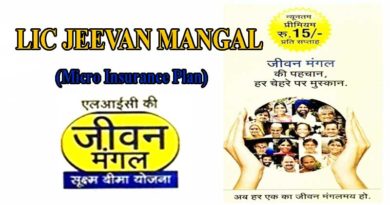LIC New Critical Illness Benefit Rider (UIN: 512A212V01)
LIC New Critical Illness Benefit Rider (UIN: 512A212V01) is available as an optional rider at the inception of the policy by payment of additional premium. The premium for this rider has to be paid along with the premiums of the Base plan and any other riders opted along with the base plan.
If the LIC New Critical Illness Benefit Rider is opted, then on the first diagnosis of the 15 Critical Illness Covered under this rider, the Critical Illness Sum Assured shall be payable.
It is a non-linked rider which will reduce the financial burden in case the Life Assured is diagnosed as suffering from any of the pre-specified critical illnesses. This rider shall only be attached with non-linked plans at the inception of the base policy and will provide an add-on benefit to the base plan.
The Critical Illness rider premium rates are guaranteed for a period of the first 5 years from the date of commencement of the policy. The Premium rates for future years will be subject to revision based on the Corporation’s experience under this rider.
LIC New Critical Illness Benefit Rider Benefit:
- On the first diagnosis of any one of the 15 Critical Illnesses as mentioned below, the Critical Illness Sum Assured shall be payable.
- The Critical Illness Rider shall be payable only once during the term of the policy.
- The Rider ceases to apply once the Critical Illness Sum Assured becomes payable.
Conditions and restrictions:
| Sr.No. | Particulars | Eligibility Conditions |
| 1 | Minimum Entry Age | 18 years (completed) |
| 2 | Maximum Entry Age | 65 years (nearer birthday) |
| 3 | Addition of Rider under an in-force policy. | No option available. |
| 4 | Rider Term | As per base plan or (75 – age at entry) years, whichever is earlier. Range: 5 years to 35 years |
| 5 | Cover Ceasing Age | 75 years (nearer birthday) |
| 6 | Minimum Sum Assured | Rs 1,00,000/- Further in multiples of Rs.25,000/- |
| 7 | Maximum Sum Assured | Rs 25,00,000/- |
What are the Critical Illnesses covered under the LIC New Critical Illness Benefit Rider?
1) CANCER OF SPECIFIED SEVERITY:
- A malignant tumor characterized by the uncontrolled growth and spread of malignant cells with invasion and destruction of normal tissues. This diagnosis must be supported by histological evidence of malignancy. The term cancer includes leukemia, lymphoma, and sarcoma.
- The following are excluded –
- All tumors which are histologically described as carcinoma in situ, benign, pre-malignant, borderline malignant, low malignant potential, neoplasm of unknown behavior, or non-invasive, including but not limited to Carcinoma in situ of breasts, Cervical dysplasia CIN-1, CIN -2 and CIN-3.
- Any non-melanoma skin carcinoma unless there is evidence of metastases to lymph nodes or beyond;
- Malignant melanoma that has not caused invasion beyond the epidermis;
- All tumors of the prostate unless histologically classified as having a Gleason score greater than 6 or having progressed to at least clinical TNM classification T2N0M0
- All Thyroid cancers histologically classified as T1N0M0 (TNM Classification) or below;
- Chronic lymphocytic leukemia less than RAI stage 3
- Non-invasive papillary cancer of the bladder histologically described as TaN0M0 or of a lesser classification,
- All Gastro-Intestinal Stromal Tumors histologically classified as T1N0M0 (TNM Classification) or below and with mitotic count of less than or equal to 5/50 HPFs.
- All tumors in the presence of HIV infection.
2) OPEN CHEST CABG:
- The actual undergoing of heart surgery to correct the blockage or narrowing in one or more coronary artery(s), by coronary artery bypass grafting done via a sternotomy (cutting through the breast bone) or minimally invasive keyhole coronary artery bypass procedures. The diagnosis must be supported by a coronary angiography and the realization of surgery has to be confirmed by a cardiologist.
- The following are excluded: Angioplasty and/or any other intra-arterial procedure
3) MYOCARDIAL INFARCTION
- The first occurrence of heart attack or myocardial infarction, which means the death of a portion of the heart muscle as a result of inadequate blood supply to the relevant area. The diagnosis for Myocardial Infarction should be evidenced by all of the following criteria:
- A history of typical clinical symptoms consistent with the diagnosis of acute myocardial infarction (For e.g. typical chest pain)
- New characteristic electrocardiogram changes
- Elevation of infarction specific enzymes, Troponins, or other specific biochemical markers.
- The following are excluded:
- Other acute Coronary Syndromes
- Any type of angina pectoris
- A rise in cardiac biomarkers or Troponin T or I in the absence of overt ischemic heart disease OR following an intra-arterial cardiac procedure.
4) KIDNEY FAILURE REQUIRING REGULAR DIALYSIS
- End-stage renal disease presenting as chronic irreversible failure of both kidneys to function, as a result of which either regular renal dialysis (hemodialysis or peritoneal dialysis) is instituted or renal transplantation is carried out. Diagnosis has to be confirmed by a specialist medical practitioner.
5) MAJOR ORGAN /BONE MARROW TRANSPLANT (as a recipient)
- The actual undergoing of a transplant of:
- One of the following human organs: heart, lung, liver, kidney, pancreas, that resulted from an irreversible end-stage failure of the relevant organ, or
- Human bone marrow using hematopoietic stem cells. The undergoing of a transplant has to be confirmed by a specialist medical practitioner.
- The following are excluded:
- Other stem-cell transplants
- Where only islets of Langerhans are transplanted
6) STROKE RESULTING IN PERMANENT SYMPTOMS
- Any cerebrovascular incident producing permanent neurological sequelae. This includes infarction of brain tissue, thrombosis in an intracranial vessel, hemorrhage, and embolization from an extracranial source. Diagnosis has to be confirmed by a specialist medical practitioner and evidenced by typical clinical symptoms as well as typical findings in CT Scan or MRI of the brain. Evidence of permanent neurological deficit lasting for at least 3 months has to be produced.
- The following are excluded:
- Transient ischemic attacks (TIA)
- Traumatic injury of the brain
- Vascular disease affecting only the eye or optic nerve or vestibular functions.
7) PERMANENT PARALYSIS OF LIMBS
- Total and irreversible loss of use of two or more limbs as a result of injury or disease of the brain or spinal cord. A specialist medical practitioner must be of the opinion that the paralysis will be permanent with no hope of recovery and must be present for more than 3 months.
8) MULTIPLE SCLEROSIS WITH PERSISTING SYMPTOMS
- The unequivocal diagnosis of Definite Multiple Sclerosis confirmed and evidenced by all of the following:
- investigations including typical MRI findings which unequivocally confirm the diagnosis to be multiple sclerosis and
- there must be current clinical impairment of motor or sensory function, which must have persisted for a continuous period of at least 6 months.
- Other causes of neurological damage such as SLE and HIV are excluded.
9) AORTIC SURGERY:
- The actual undergoing of major surgery to repair or correct an aneurysm, narrowing, obstruction, or dissection of the aorta through a surgical opening of the chest or abdomen. For the purpose of this definition, aorta shall mean the thoracic and abdominal aorta but not its branches.
- Surgery performed using only minimally invasive or intra-arterial techniques are excluded.
10) PRIMARY (IDIOPATHIC) PULMONARY HYPERTENSION
- An unequivocal diagnosis of Primary (Idiopathic) Pulmonary Hypertension by a Cardiologist or specialist in respiratory medicine with evidence of right ventricular enlargement and the pulmonary artery pressure above 30 mm of Hg on Cardiac Cauterization. There must be a permanent irreversible physical impairment to the degree of at least Class IV of the New York Heart Association Classification of cardiac impairment.
- The NYHA Classification of Cardiac Impairment are as follows:
- Class III: Marked limitation of physical activity. Comfortable at rest, but less than ordinary activity causes symptoms.
- Class IV: Unable to engage in any physical activity without discomfort. Symptoms may be present even at rest.
- Pulmonary hypertension associated with lung disease, chronic hypoventilation, pulmonary thromboembolic disease, drugs and toxins, diseases of the left side of the heart, congenital heart disease, and any secondary cause is specifically excluded.
11) ALZHEIMER’S DISEASE/DEMENTIA:
- Deterioration or loss of intellectual capacity as confirmed by clinical evaluation and imaging tests, arising from Alzheimer’s Disease or irreversible organic disorders, resulting in a significant reduction in mental and social functioning requiring the continuous supervision of the Life Assured for a minimum period of 6 months from date of diagnosis. This diagnosis must be supported by the clinical confirmation of an appropriate Registered Medical practitioner who is also a Neurologist and supported by the Corporation’s appointed doctor.
- The following are excluded:
- Non-organic disease such as neurosis and psychiatric illnesses; and
- Alcohol-related brain damage
12) BLINDNESS
- Total, permanent, and irreversible loss of all vision in both eyes as a result of illness or accident.
- The Blindness is evidenced by:
- corrected visual acuity is 3/60 or less in both eyes or ;
- the field of vision is less than 10 degrees in both eyes.
- The diagnosis of blindness must be confirmed and must not be correctable by aids or surgical procedures.
13) THIRD DEGREE BURNS
- There must be third-degree burns with scarring that cover at least 20% of the body’s surface area. The diagnosis must confirm the total area involved using standardized, clinically accepted, body surface area charts covering 20% of the body surface area.
14) OPEN HEART REPLACEMENT OR REPAIR OF HEART VALVES
- The actual undergoing of open-heart valve surgery is to replace or repair one or more heart valves, as a consequence of defects in, abnormalities of, or disease-affected cardiac valve(s). The diagnosis of the valve abnormality must be supported by an echocardiography and the realization of surgery has to be confirmed by a specialist medical practitioner. Catheter-based techniques including but not limited to, balloon valvotomy/valvuloplasty are excluded.
15) BENIGN BRAIN TUMOR
- Benign brain tumor is defined as a life-threatening, non-cancerous tumor in the brain, cranial nerves, or meninges within the skull. The presence of the underlying tumor must be confirmed by imaging studies such as CT scan or MRI.
- This brain tumor must result in at least one of the following and must be confirmed by the relevant medical specialist.
- The permanent neurological deficit with persisting clinical symptoms for a continuous period of at least 90 consecutive days or
- Undergone surgical resection or radiation therapy to treat the brain tumor.
- The following conditions are excluded:
- Cysts, Granulomas, malformations in the arteries or veins of the brain, hematomas, abscesses, pituitary tumors, tumors of skull bones, and tumors of the spinal cord.
LIC New Critical Illness Benefit Rider EXCLUSIONS:
- Any of the listed critical illness conditions where death occurs within 30 days from the date of diagnosis
- Any sickness condition related to the illnesses covered under this rider manifesting itself within 90 days of the commencement of risk or revival of risk cover, whichever is later.
- Intentionally self-inflicted injury or attempted suicide, irrespective of mental condition.
- Alcohol or solvent abuse, or the taking of drugs except under the direction of a registered medical practitioner*.
- War, invasion, hostilities (whether war is declared or not), civil war, rebellion, revolution, or taking part in a riot or civil commotion.
- Taking part in any act of a criminal nature
- Any Pre-existing medical condition i.e. any condition, ailment, or injury or related condition (s) for which the policyholder had signs or symptoms, and/or were diagnosed, and/or received medical advice/treatment within 48 months prior to the date of commencement/ revival of the policy.
- HIV or AIDS
- Failure to seek medical or follow medical advice (i.e. failure to undergo tests or treatments that a prudent person would normally undergo as recommended by a Medical Practitioner*.
- Radioactive contamination due to nuclear accident.




